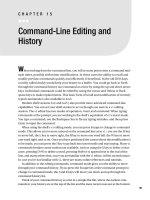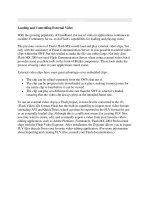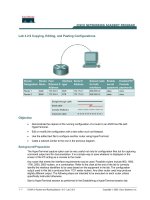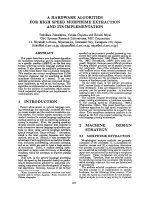high definition postproduction editing and delivering hd video
Bạn đang xem bản rút gọn của tài liệu. Xem và tải ngay bản đầy đủ của tài liệu tại đây (6.86 MB, 249 trang )
High Definition Postproduction:
Editing and Delivering HD Video
FM.indd iFM.indd i 11/6/06 8:31:56 PM11/6/06 8:31:56 PM
This page intentionally left blank
High Definition
Postproduction:
Editing and
Delivering HD
Video
Steven E. Browne
AMSTERDAM • BOSTON • HEIDELBERG • LONDON
NEW YORK • OXFORD • PARIS • SAN DIEGO
SAN FRANCISCO • SINGAPORE • SYDNEY • TOKYO
Focal Press is an imprint of Elsevier
FM.indd iiiFM.indd iii 11/6/06 8:31:57 PM11/6/06 8:31:57 PM
Senior Acquisitions Editor: Elinor Actipis
Assistant Editor: Robin Weston
Marketing Manager: Christine Degon Veroulis
Senior Project Manager: Brandy Lilly
Cover Designer: Eric DeCicco
Focal Press is an imprint of Elsevier
30 Corporate Drive, Suite 400, Burlington, MA 01803, USA
Linacre House, Jordan Hill, Oxford OX2 8DP, UK
Copyright © 2007, Steven E. Browne. All rights reserved.
No part of this publication may be reproduced, stored in a retrieval system, or transmitted
in any form or by any means, electronic, mechanical, photocopying, recording, or otherwise,
without the prior written permission of the publisher.
Permissions may be sought directly from Elsevier’s Science & Technology Rights Department
in Oxford, UK: phone: (+44) 1865 843830, fax: (+44) 1865 853333, E-mail:
You may also complete your request on-line via the Elsevier
homepage (), by selecting “Support & Contact” then “Copyright and
Permission” and then “Obtaining Permissions.”
Recognizing the importance of preserving what has been written, Elsevier prints its books on
acid-free paper whenever possible.
Library of Congress Cataloging-in-Publication Data
Application submitted
British Library Cataloguing-in-Publication Data
A catalogue record for this book is available from the British Library.
ISBN-13: 978-0-240-80839-0
ISBN-10: 0-240-80839-8
For information on all Focal Press publications
visit our Web site at www.books.elsevier.com
Printed in the United States of America
06 07 08 09 10 11 10 9 8 7 6 5 4 3 2 1
FM.indd ivFM.indd iv 11/14/06 1:09:47 PM11/14/06 1:09:47 PM
For the hours of understanding, patience, and support…
In other words, for all the help and love, I would like to
dedicate this book to my life companion and wife, Michele,
without whom this book would not exist.
FM.indd vFM.indd v 11/6/06 8:31:57 PM11/6/06 8:31:57 PM
This page intentionally left blank
Contents
Dedication v
Acknowledgments xiii
Introduction xv
Chapter 1 High Definition—A Multi-Format Video 1
Why This Book Exists 1
High Definition is Settling Down and Growing Up 4
High Definition Size 4
Delivery Determines Production Format 4
History 5
A Typical Family 5
The “Universal” Format 8
Even More Choices and Confusion 9
High Definition is Not New 10
Government Gives Additional Channels
for Television Stations 15
HDV Excitement 16
Europe Heads Into HD Land 17
More United States Government Mandates 18
Digital Broadcasting is Not Necessarily HD 18
Why Digital Broadcasting is So Important to
the Government 19
Broadcast Formats 20
High Definition Decoder/Tuner 21
HD is a Series of Formats 21
Formats Keep Arriving 23
Chapter One Summary 24
Chapter 2 What Is High Definition? 27
Frame Rate 29
Frame Recording Method 32
Contrast Between Progressive and Interlaced 32
vii
FM.indd viiFM.indd vii 11/6/06 8:31:58 PM11/6/06 8:31:58 PM
Bit Depth 34
Chroma Subsampling 36
Compression 38
Putting It Together 39
The Production Choice 39
Mixing SD and HD 41
High Definition Production Choice Summary 43
Everything is Changing 43
When HD is Not True HD: Uprezing Video to HD 44
Budget Considerations 45
Computer File Size for High Definition Video 46
Conversion Problems 46
True Versus Converted Frames 47
How to Choose an HD Format for a Particular Show 47
Offline/Online Edit System Compatibility 48
Nonlinear Editors With No Frame Rate Restrictions 49
HD is Looking Good 49
Lossy Versus Lossless Compression 49
Shoot, Edit, and Deliver at One Frame
Rate—What a Concept 51
Chapter Two Summary 51
High Definition Production Choice Summary 55
Chapter 3 Myths and Questions About HD 57
Can HD Be Seen on a Regular Television? 59
Why Are There So Many High Definition Frame Rates? 61
Why Did Congress Delay Turning Off the NTSC
Broadcast Channels? 62
Is Digital TV HD? 63
Is Uncompressed the Best Way to Shoot HD? 63
Is HD Digital TV? 64
Do Television Stations Always Broadcast the Same Signal on
Their Digital and Analog Channels? 65
Is HDV the Same Quality as HD? 65
Is High Definition Recorded the Same Way on All HD
Machines? 66
Is HD Used for Film Production? 66
Are High Definition Images Always Used in the Digital
Intermediate Process? 67
Doesn’t Film Have More Resolution Than HD? 67
viii CONTENTS
FM.indd viiiFM.indd viii 11/6/06 8:31:58 PM11/6/06 8:31:58 PM
Isn’t HD Just Like NTSC Only Wider and
With More Detail? 68
Is It True That a High Definition Frame Contains
Much More Information Than an NTSC
(Standard Definition) Frame? 69
Is HD Going to Replace Film? 69
Is HD Going to Replace SD? 71
Is HD the Best Format? 72
Is Any HD Recording High Definition? 72
Do Progressive Frames Have More Visual Quality
Than Interlaced Frames? 73
Will I Always Receive the Same High Definition Quality
Images on My High Definition Television Set? 75
Chapter Three Summary 75
Chapter 4 More on the Technical Side 79
Frame Rates 79
1080psf23.98 80
1080i59.94 (a.k.a. 1080i29.97) 80
1080p24, 720p24, 720p23.98, and 1080psf23.98 80
720p59.94 81
1080psf29.97 82
Integer Frame Rates 82
Mbps 83
Throughput Needs 85
All Compressions Are Not Equal 86
More Compression in Broadcasting 86
Rapid Camera Development 89
Editing Systems 90
Single Editor—Single System 91
Medium-Scale Access and Post Challenges 92
Hardware Acceleration 93
Codecs 94
Linear Online Editing 96
Chapter Four Summary 98
Chapter 5 Preparing for and Shooting in High Definition 101
The Video Village 102
Tube Versus Flat Screen 103
Standard Definition Protection Framing 103
Contents ix
FM.indd ixFM.indd ix 11/6/06 8:31:58 PM11/6/06 8:31:58 PM
Camera Lenses Are a Vital Aspect of Any Production 104
Editing HDV 106
HD 1080i59.94 Master With NTSC Media and a
NTSC Delivery 107
Mixing SD (NTSC 29.97) With HD 23.98 Master
NTSC 29.97 Delivery Frame Rate 107
Tape Versus Optical Disk or Solid State Media 109
Recording Media to Disk 110
Infinity Camera—Non-Tape Storage With
Several Options 111
Delivery Requirements 113
Motion Effects and Alternative Frame
Rates/Sizes—Change Tapes 114
23.98 is Not 24; 29.97 is Not 30 But Could Be
59.94i or 29.97p 115
Camera and Record Deck Consideration—Testing
and Monitoring 115
Keeping Updated Via Email 116
Editorial Equipment Consideration 116
Tape Labeling in the Field 117
Audio Concerns 117
Heads and Tails 118
Makeup 118
Slates, Tape Logs, Clapsticks 118
Slating 119
Clapsticks 120
Lighting 120
Camera Movement 120
23.98 Speed of Camera Movement 121
Time of Day Versus Continuous Run Time Code 122
Graphics 123
Delivery Issues 123
Dolby 5.1 125
Chapter Five Summary 125
Chapter 6 Real Postproduction Paths 129
That Guy 129
HD Shoot, HD Edit, HD Finish 129
Super Bowl Feature Film Commercial—Example One 135
Film Origination, HD Edit, and Delivery 135
Let Me Count the Ways 142
x CONTENTS
FM.indd xFM.indd x 11/6/06 8:31:58 PM11/6/06 8:31:58 PM
HD Production, HD Post, HD Delivery 142
Super Bowl Feature Film Commercial—Example Two 143
Film Origination, HD Edit, and Delivery 143
American Idol 145
Dane Cook's Tourgasm 146
HDV Production, HD Post, HD Delivery 146
Staring at the Sun 149
Film Production, HD Post, Film Delivery 149
Kidney Thieves 151
Film Production, HD Post, HD Delivery 151
Unnamed HD DVD Project 152
HD Production, HD Post, HD Delivery 152
Kevin Smith 153
HD Production, HD Post, HD Delivery 153
A Place to Rest My Head 154
HDV Production, HDV Post, HD Delivery 154
Top Secret Project 156
HD Production, HD Post, HD Delivery 156
Every Network Has Its Own Rules 156
Chapter 7 Other Editing Issues 159
Viewing HD 159
LCD Monitors 161
Plasma Screens 162
DLP Monitors 162
Time Code Display from High Definition Decks 163
Understanding Different Aspect Ratios in SD 164
Edit System Compatibility 165
The Preload 167
Testing Workflow and Media Accuracy 168
Edit System Updates 168
Intermediate Codecs Versus “Native” Editing 168
Data Management 169
Data Protection 170
Mixing Frame Rates 170
Fixing It Yourself 170
Credit Rolls in the 23.98 Frame Rate 171
Organization and Data Protection 172
Time Management 172
Politics 172
The Newest Fad 173
Contents xi
FM.indd xiFM.indd xi 11/6/06 8:31:59 PM11/6/06 8:31:59 PM
Connections 173
Keeping It Simple 173
Chapter Seven Summary 174
Chapter 8 HD, Film, and Digital Intermediates 177
HD for Feature Film 180
The Details 181
Shoot HD, Edit Offline, Conform HD, Enter DI,
Output Film 181
Shoot Film, Edit Offline, Cut Film Negative, Enter DI,
Output Film 182
LUTs 184
Not to Be Taken Lightly 184
The Video Versus Film Gap 184
Film is Not a Good Duplication Medium 186
The End of Film? 186
Chapter Eight Summary 187
Chapter 9 Employment Opportunities and
New Horizons 189
On the Horizon 190
Future Sales of Today’s Productions 191
High Def Will Be the Norm 191
Chapter 10 Steve Browne’s Personal Summary 193
HDV Works! 194
A Few HD Connections 195
FireWire 195
HD-SDI 196
DVI 197
HDMI 197
USB 2.0 198
Ethernet 198
Glossary 199
Index 221
xii CONTENTS
FM.indd xiiFM.indd xii 11/6/06 8:31:59 PM11/6/06 8:31:59 PM
Acknowledgments
Nothing of value is ever easy, especially putting together a book.
No matter how short or long it is, there are people who provide
support, information, and expertise to help create the text. It is these
people I would like to thank for all their help with this book.
Thanks go to Mark Coan, Brittaney Parbs, Mark Rodrigues, and
Paul Apel from New Wave Entertainment. I would also like to
extend my appreciation to Elinor Actipis, Betsy Harrell, and Robin
Weston from Focal Press.
Also, a thank you goes to Dane Cook, Brian Volk-Weiss, Vito J.
Giambalvo, Breht Gardner, and Toby Wilkins for their help with
the real-life examples of high definition programs.
And a very special thank you to Graeme Natress, whose thoughts
and comments were priceless.
FM.indd xiiiFM.indd xiii 11/6/06 8:31:59 PM11/6/06 8:31:59 PM
This page intentionally left blank
Introduction
When I first saw a high definition (HD) image, I was amazed. The
picture was vibrant and filled with tremendous detail. After buy-
ing my own “HD ready” high definition television with a separate
tuner, I was even more impressed that I could watch this stunning
broadcast in my home. I could see individual faces in a football
crowd. The raindrops during a live baseball game looked like real
rain, not blurry streaks that got in my way.
It wasn't long before I was dealing with the details of high defini-
tion postproduction. I quickly learned that it might be easy to watch
a high definition broadcast, but it is another matter altogether to
actually dive into the complex and confusing high def postproduc-
tion landscape.
While standard definition NTSC certainly had created its own chal-
lenges, HD posed those challenges and more. Just trying to under-
stand the differences among 12 HD broadcast formats, along with
the increasing number of production formats, was confusing to say
the least.
Several new HD cameras have since arrived on the market, and
with the advent of optical disk and solid state media recording, vid-
eotape, at least as a production medium, may well be on its way
to the junkyard already populated by 8 tracks, VHS, and corded
phones.
But despite the confusion and many production and postproduc-
tion choices, it is obvious that the long-awaited move to HD pro-
duction has begun. Even cable producers have recognized the need
to produce their shows on HD, if for nothing else to protect the
content for future DVD and ancillary sales.
FM.indd xvFM.indd xv 11/6/06 8:31:59 PM11/6/06 8:31:59 PM
The first thing I learned in my first few discussions of high defini-
tion was this: although high definition has been around for quite a
few years, it wasn't being used very much. With little demand, high
cost, and few programs, there simply was no interest to migrate to
a new, confusing medium.
Now with the advent of HDV and affordable new HD cameras on
the market, HD is taking off.
Broadcast networks, cable programmers, and prosumers have
been instrumental in encouraging HD productions. And now, even
the general consumer has become aware of high definition—even
if they're not totally sure what it is. With the federal government
mandating television manufacturers to include high definition tun-
ers in sets, the acceptance of and interest in HD has increased tre-
mendously. Add to that the exciting advances in nonlinear editors,
HDV cameras, playback decks, and tapeless recording cameras, it's
clear that HD is here to stay.
Still, HD postproduction is not easy to understand. Even though
there are only 12 high def broadcast formats, there are over 50 pro-
duction formats, and the list is growing rapidly. Hopefully, some of
these production formats will eventually be retired; in reality, some
of these formats are “bridging formats” needed to transition from
NTSC-compatible formats to digital-only broadcasting. However,
others will remain and more are sure to be introduced.
One thing is certain: careful preproduction planning will continue
to be extremely important, especially in the HD postproduction
workflow.
Another fascinating aspect of the high def world is that HD—and
even, in some situations, HDV—is being used for productions
intended to be projected on film. And the use of HD for film is not
just for the small budget production. Major motion picture stu-
dios have already used HD as a primary production medium. The
prospect of a digital pipeline from the set and location, through
postproduction, and even into the theater is already here.
High definition can be the best thing since color broadcasting, or
it can turn into a nightmare of format conversions, confusion, lost
xvi INTRODUCTION
FM.indd xviFM.indd xvi 11/6/06 8:31:59 PM11/6/06 8:31:59 PM
effects, and hours of stress. We will take a look at this HD maze—
how others are successfully doing it, and how it is transforming the
television, industrial, and film production environments.
The two main goals of this book are to clear up many of the
misunderstandings that have evolved around high definition tech-
nologies, and to clarify how this family of formats integrates with
each other and our familiar NTSC, standard definition video.
I still remember that first day, looking at a high definition image and
being amazed. Now it appears that clarity will become the norm.
Introduction xvii
FM.indd xviiFM.indd xvii 11/6/06 8:32:00 PM11/6/06 8:32:00 PM
This page intentionally left blank
1
CHAPTER 1
High Definition—
A Multi-Format Video
“High definition” refers to a family of high quality video image
and sound formats that has recently become very popular both in
the broadcasting community and the consumer market. High defi-
nition (HD) in the United States was initially defined as any video
format that had more than 720 (horizontal) lines of vertical resolu-
tion. The ATSC (Advanced Television Systems Committee) created
a digital television (DTV) broadcast table that defined not only the
vertical resolution but also other aspects of the HD frame rate and
size. This table defined two sizes of high definition images: 720
(horizontal) by 1280 (vertical) lines and 1080 (horizontal) by 1920
(vertical) lines of resolution. Along with the two frame sizes, there
is also a choice of frame rates: 23.98, 24, 29.97, 30, 59.94, and 60
frames per second.
Why This Book Exists
Just looking at the previous paragraph, it is apparent that there
are quite a few format choices in HD. To add to the confusion,
there is an issue of manufacturers and even professionals mis-
labeling technical formats and processes. My goal is to identify
the misinformation issues and generally describe what is hap-
pening in the HD world, giving the reader a basic understanding
of what high definition is and what its possibilities are in the near
future.
The main purpose of this book is to explain the choices that HD
offers and to point to some of the current “accepted” production
Ch01.indd 1Ch01.indd 1 11/6/06 8:17:29 PM11/6/06 8:17:29 PM
2 HIGH DEFINITION—A MULTI-FORMAT VIDEO
paths that are being used today. Incredibly, there is still a great
deal of confusion even in the professional world concerning HD.
There are a few established workpaths—certainly with daily
broadcasts of HD programming on cable and OTA (over the air)
broadcasting this has to be true. Yet a lack of understanding or
just a lack of communication has created costly mistakes that
show up in the postproduction phase.
This book should, at the very least, clear up some of the mis-
conceptions and point to the easy path from production to
delivery.
Also known as “HD” and “high def,” high definition video has
rapidly become a consumer buzz word. After years of languish-
ing in the shadows of the popular and totally accepted standard
definition (NTSC) format, high definition has finally taken the
step into the spotlight. With exciting, low cost, and high quality
HDV cameras, new camera lines coming along with even more
rapid developments in editing and video displays, consumers
1080
1920
1080 ϫ 1920
with pixels
stretched to
HD
1440
1080 ϫ 1440
(HDCAM and HDV)
Figure 1.1 Several camcorders do not record the full 1920 lines of resolu-
tion when storing 1080 format. Instead, 1440 lines are recorded, and then
on play out the horizontal pixels are stretched by 33%.
Ch01.indd 2Ch01.indd 2 11/6/06 8:17:30 PM11/6/06 8:17:30 PM
and professionals alike are diving into HD with money, interest,
and passion.
HD has gone from obscurity to being a household term. High def
flatscreens have become a “must have” technological “cool item”
like the iPod and cell phone. HD has left the esoteric video world
and plunged headlong into the mainstream. High definition video
televisions, cameras, and recording devices are now being embraced
by retailers, beleaguered broadcasters, excited independent film-
makers, and even reticent movie studios. Even more exciting is the
extremely rapid pace at which improvements are being made in
the manufacturing of production equipment, editing, and effects,
and probably most importantly for continued growth, consumer
products are getting better and cheaper.
Rather than being a single record and playback format, the high
definition family offers a matrix of choices that include frame rates,
frame sizes, and compression processes. Along with these obvi-
ous differences noted in the ATSC digital television table, there are
many other production choices in high definition.
Why This Book Exists 3
Table 1.1 The HD ATSC Broadcast Table.
Format Vertical Horizontal Aspect Scan Frame
Level Pixels Pixels Ratio Mode Rate
HD 1080 1920 16:9 Progressive 24 or 23.98
HD 1080 1920 16:9 Progressive 30 or 29.97
HD 1080 1920 16:9 Interlaced 30 or 29.97
HD 720 1280 16:9 Progressive 24 or 23.98
HD 720 1280 16:9 Progressive 30 or 29.97
HD 720 1280 16:9 Progressive 60 or 59.94
The HD ATSC broadcast table shown displays the 12 high definition broad-
cast formats, six of which are designed to integrate with the NTSC broadcast
frame rate. When the analog NTSC broadcasting frequencies are returned
to the federal government in February of 2009, the integer frame rates will
probably be used more often. Many professionals think there are only six high
definition digital broadcast formats, but these are the NTSC compatible frame
rates. The others are integer frame rates either used for true film transfer or
for future integer frame rates. Note that the only interlaced format is the 1080
frame size.
Ch01.indd 3Ch01.indd 3 11/6/06 8:17:31 PM11/6/06 8:17:31 PM
4 HIGH DEFINITION—A MULTI-FORMAT VIDEO
These options of what format to shoot and deliver are usually decided
by the network or the broadcast company long before production
commences so that the postproduction workflow runs smoothly.
Students, independent filmmakers, and documentary producers are
choosing alternative workflow paths. These creative individuals are
pioneering new ground and techniques, some of which have been
embraced, while others have been left behind as unsuccessful.
High Definition is Settling Down
and Growing Up
When one first realizes the great number of production format
choices that currently exist, making the decision as to the correct one
for your project can seem overwhelming. But there are some con-
solations. There are several production formats that have become
established as standards.
High Definition Size
In the broadcasting world, most professionals refer to HD as video
that is compatible with the 12 standards as defined by the ATSC DTV
broadcasting table. As mentioned earlier, the ATSC DTV table cites two
frame sizes for high definition: 720 (vertical) by 1280 (horizontal) lines
and 1080 (vertical) by 1920 (horizontal). However, there are several
video recording processes that record 1440 horizontal lines of resolu-
tion in a horizontally reduced ratio. Then, when it is played out, the
horizontal pixels are stretched by 33% to produce 1920 lines of resolu-
tion (HDCAM and HDV) (see Figure 1.1).
Delivery Determines Production Format
When considering a production’s acquisition format, one has to
examine the delivery aspect of the program to determine how the
high definition image will be recorded.
The particular aspects that should be considered are the following:
● Frame size—either 1080 or 720 vertical lines of resolution
Ch01.indd 4Ch01.indd 4 11/6/06 8:17:31 PM11/6/06 8:17:31 PM
● Frame rate—23.98, 24, 29.97, 30, 59.94 or 60 frames per second
● Bit depth—usually eight bits but sometimes 10
● Compression—a variety of types exist, the most common of
which is chroma subsampling
At this time, there are over 60 production and manufacturer choices
in the high definition family, and more are on the way.
History
The HD choices began when the ATSC created the digital television
table of 36 digital broadcast (DTV) formats. Of those 36 formats,
12 are high definition. These are the formats that the United States
government has determined will be the standard for digital broad-
casting.
Just as there are many compatible production formats devel-
oped for NTSC broadcast, the 12 high definition formats also
have a number of compatible production formats to choose from.
However, where NTSC has a single frame rate and a single frame
size, the DTV high definition format has a dozen different choices.
As a result, there are even more possibilities when it comes to the
hardware that captures and records those images.
Also, as technology improved, each NTSC production format was
basically compatible with the next. However, in the high definition
world, not all the frame rates are compatible with each other.
The net result is that there is often confusion about which format
should be used.
A Typical Family
In reality, high definition is not a single format at all, but a family of
broadcast and production formats with a variety of choices on the
set, in postproduction, and even for broadcasters.
A Typical Family 5
Ch01.indd 5Ch01.indd 5 11/6/06 8:17:31 PM11/6/06 8:17:31 PM
6 HIGH DEFINITION—A MULTI-FORMAT VIDEO
The reason for this is that the interlaced 29.97 format has 59.94
images per second, and this notation sets it dramatically apart from
the progressive frame rate. It could also be notated as 1080i29.97,
but one can see the potential for confusion. It can also be called
1080i, 29.97i, and 1080i59.94.
For the purpose of this text, interlaced 1080 will be noted as
1080i59.94.
Because not all the high definition frame rates are compatible with
each other, preproduction planning is vital to the success of any
high definition project, much more than for a standard definition
project.
Ideally, the delivery frame size and frame rate should be estab-
lished well before any production begins. This allows for testing of
specific cameras, editing equipment, and even effects. There are so
many new developments occurring in the HD equipment world,
one should always check to see what the current workflow, equip-
ment, and other devices are that have become accepted into the HD
community.
Some formats can only be digitized or edited on specific editing
systems. Shooting at an incompatible or different frame rate and/
or frame size from the final delivery format can potentially cause
● There are three elements that are usually indicated in a high defi-
nition notation: frame size, recording method, and image rate.
Because this format is new to many people, the order of these
aspects is not standardized, and there are verbal shortcuts.
● For the purpose of consistency, this book will notate HD in the fol-
lowing pattern:
● Frame size, recording method, and image rate. So a 1080 frame
size shot progressive segmented at 29.97 would be notated as the
following:
● 1080psf29.97
● However, a 1080 interlaced at 29.97 is usually notated as
1080i59.94
Ch01.indd 6Ch01.indd 6 11/6/06 8:17:31 PM11/6/06 8:17:31 PM









